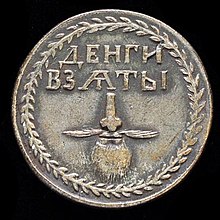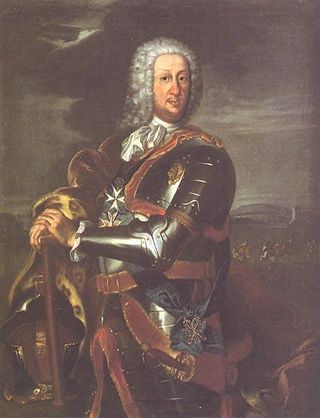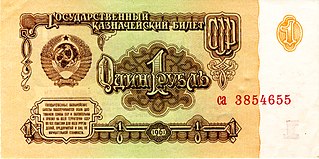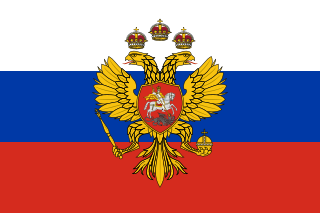
A beard tax is a governmental policy that requires men to pay for the privilege of wearing a beard. The most well documented beard tax was in place in Russia during the 18th century.

A beard tax is a governmental policy that requires men to pay for the privilege of wearing a beard. The most well documented beard tax was in place in Russia during the 18th century.

In 1698, [1] Tsar Peter I of Russia instituted a beard tax as part of an effort to bring Russian society in line with Western European models. To enforce the ban on beards, the tsar empowered police to forcibly and publicly shave those who refused to pay the tax. [2] Resistance to going clean shaven was widespread with many believing that it was a religious requirement for a man to wear a beard, [3] and the Russian Orthodox Church declared being clean-shaven as blasphemous. [4]
The tax levied depended upon the status of the bearded man: those associated with the Imperial Court, military, or government were charged 60 rubles annually; [lower-alpha 1] wealthy merchants were charged 100 rubles per year while other merchants and townsfolk were charged 60 rubles per year; Muscovites were charged 30 rubles per year; and peasants were charged two half-kopeks every time they entered a city. [6]
The tax raised an average of 3,588 rubles annually from 1705 to 1708. However, from a financial standpoint, the tax was unsuccessful due both to the relatively low number of people unwilling to shave their beards and an overestimation of the ability of the Russian state to administer and collect the tax. [7] In 1772, the tax was formally repealed by Catherine the Great. [8]
Those who paid the tax were required to carry a "beard token" (Russian : Бородовой знак) or "beard kopek" (бородовая копейка). [9] This was a copper or silver token with a Russian Eagle on the reverse and on the obverse the lower part of a face with nose, mouth, whiskers, and beard. Several versions were minted between the issuance of the decree and its lifting in 1772. [10] The first token minted in 1698 or 1699 was a simple copper penny of which only two specimens have been found. [11] It was followed by the more common round, copper token minted in 1705 and again in 1710. A rhomboid version was issued in 1724 and 1725. [12] Walter Hawkins published a paper in 1845 illustrating an example of the token from his own collection and describing the history of the tax in Russia. [13]
The 1699 and 1705 versions were inscribed with the words "money taken" (ДЕНГИ ВЗѦТЫ) on the obvers, and the date in Cyrillic numerals (҂АѰЕ ГОДѸ, "Year 1705") on the reverse of the 1705 token; the 1710 version was largely the same with an updated date (҂АѰІ, "1710"). The rhomboid version of 1724/1725 was smooth on the reverse with the phrase "beard tax taken" (СБОРОДЫ ПОШЛИНА ВЗЯТА) on the obverse and "the beard is a superfluous burden" (БОРОДА ЛИШЬНАѦ ТѦГОТА) on the edge. The date on the later tokens was written in Arabic numerals. [11] [14] [15]
A persistent legend claims that King Henry VIII of England, who wore a beard himself, introduced a tax on beards, and that his eventual successor Elizabeth I tried unsuccessfully to increase the tax. [16] Contemporary documentation of the Tudor beard tax, however, is lacking, and The National Archives has no record of such a tax having been instituted. [17]
The bearded Francis I of France received approval from the pope in the early 1500s to levy a tax on priests' beards in part to fund his wars with the Holy Roman Empire. This led to a divide between the wealthier court ecclesiastics who could afford the tax and poorer village priests who could not. [18] [19]
In 1936, the Kingdom of Yemen introduced a "no-beard tax," allowed men with clean-shaven faces to pay a tax in lieu of growing a beard. [20] This policy differed from the approach taken in other Islamic nations where tradition and sharia law have been used to require the growing of beards under threat of punishment. [21]

Peter I, commonly known as Peter the Great, was Tsar of all Russia from 1682, and the first Emperor of all Russia from 1721 until his death in 1725. He reigned jointly with his half-brother Ivan V until 1696. From this year, Peter was an absolute monarch who remained the ultimate authority. His methods were often harsh and autocratic.

Alexei Mikhailovich the Quietest, also known as Alexis, was Tsar of all Russia from 1645 until his death in 1676.

A beard is the hair that grows on the jaw, chin, upper lip, lower lip, cheeks, and neck of humans and some non-human animals. In humans, usually pubescent or adult males are able to start growing beards, on average at the age of 21.
Decimalisation or decimalization is the conversion of a system of currency or of weights and measures to units related by powers of 10.

The ruble or rouble is the currency of the Russian Federation. The ruble is subdivided into 100 kopecks. It is used in Russia as well as in the parts of Ukraine under Russian military occupation and in Russian-occupied parts of Georgia.

Count Boris Petrovich Sheremetev was an Imperial Russian diplomat and general field marshal during the Great Northern War. He became the first Russian count in 1706. His children included Pyotr Sheremetev and Natalia Sheremeteva.

The ruble is the currency of the internationally unrecognized state of Transnistria and is divided into 100 kopecks.

The ruble, rouble or rubel is the currency of Belarus. It is subdivided into 100 kopecks.

The ruble or rouble was the currency of the Soviet Union. It was introduced in 1922 and replaced the Imperial Russian ruble. One ruble was divided into 100 kopecks. Soviet banknotes and coins were produced by the Federal State Unitary Enterprise in Moscow and Leningrad.

Joint Stock Company "Goznak"/"Гознак" is a Russian joint-stock company responsible for research and development as well as manufacturing security products including banknotes, coins, stamps, identity cards, secure documents, state orders and medals, as well as providing secure services. It incorporates seven factories and one research and development institute involved in different stages of the development, research, and manufacturing cycle.

The ruble or rouble is the currency unit of Belarus and Russia. Historically, it was the name of the currency of the Russian Empire and, later, of the Soviet Union.

The government reforms of Peter I aimed to modernize the Tsardom of Russia based on Western European models.

A denga was a Russian monetary unit with a value latterly equal to 1⁄2 kopeck.
Chervonets is the traditional Russian name for large foreign and domestic gold coins. The name comes from the Russian term червонное золото, meaning 'red gold' – the old name of a high-grade gold type.

The Tsardom of Russia or the Russian Tsardom and Tsardom of Rus', also known as the Tsardom of Muscovy, was the centralized Russian state from the assumption of the title of tsar by Ivan IV in 1547 until the foundation of the Russian Empire by Peter the Great in 1721.

The Battle of Erastfer took place on 29 December 1701 (O.S.) / 30 December 1701 / 9 January / 1702 (N.S.) near Erastfer in eastern Swedish Livonia between a Russian force of around 13,000 regulars along with 6,000 irregulars led by general Boris Sheremetev and a Swedish force of about 3,470 men, under the command of Wolmar Anton von Schlippenbach. The Swedes were defeated, with a loss of 1,000 men killed and captured along with all their artillery pieces. The Russians sustained about 1,000 killed along with another 2,000 wounded.

Facial hair in the military has been at various times common, prohibited, or an integral part of the uniform.
Peter the Great became the new Tsar of Russia in 1682 and ruled until 1725. During his rule, Peter brought many reforms in order to open the window to Europe for Russia. Economic reforms played an important role in the transformation of Russia. With these economic reforms, Russia achieved a good standing among the European countries in areas such as manufacturing, trade, and military. These economic reforms would boost Russia well into the 18th century, which were aimed to provide highly positive benefits for the Russian population.
Secular laws regulating hairstyles exist in various countries and institutions.
The Russian Empire minted platinum coins from 1828 to 1845, with face values of 3, 6, and 12 rubles.
{{cite encyclopedia}}: CS1 maint: location missing publisher (link)